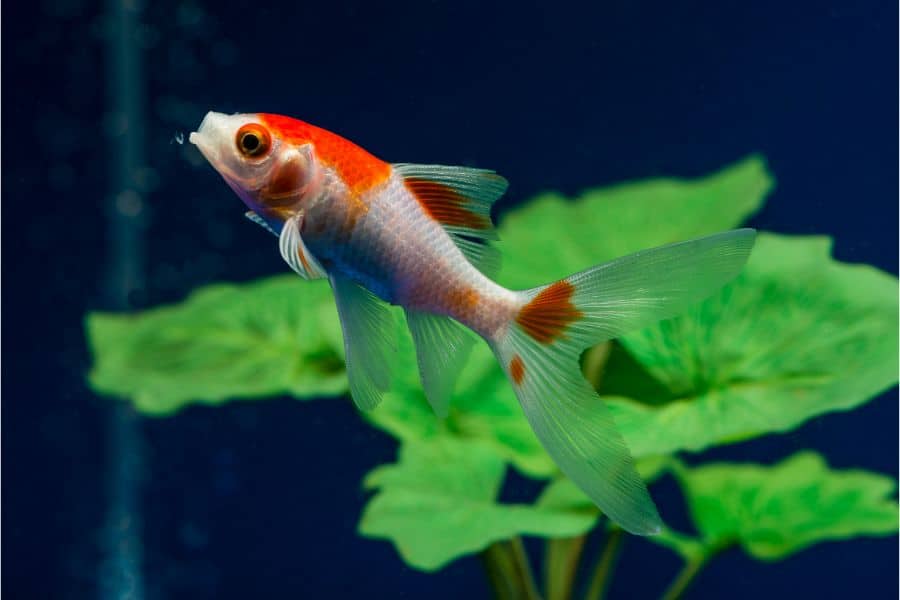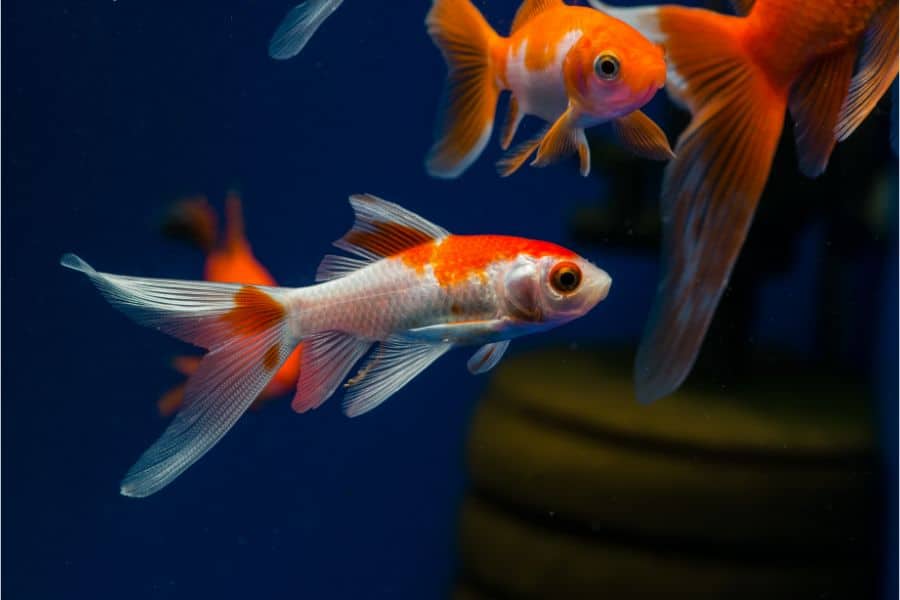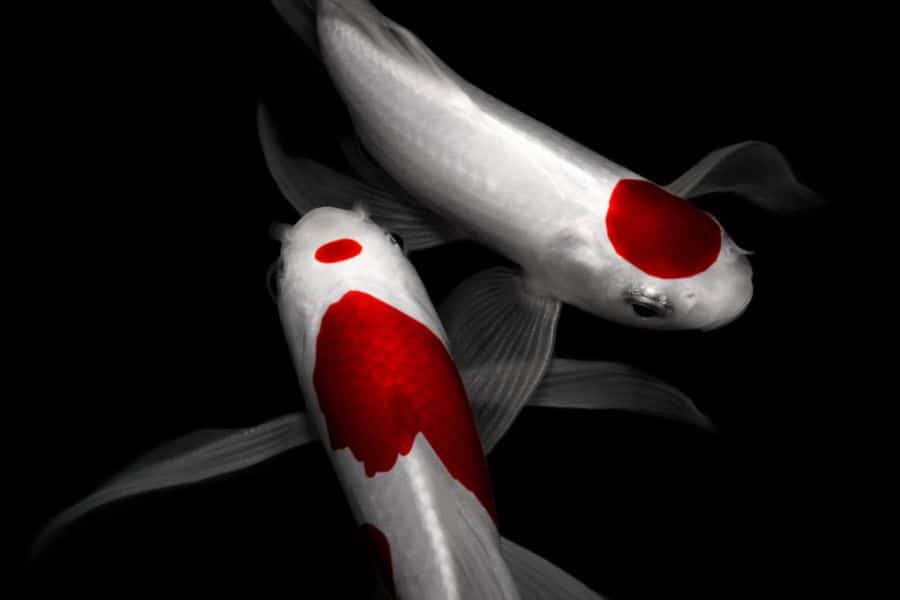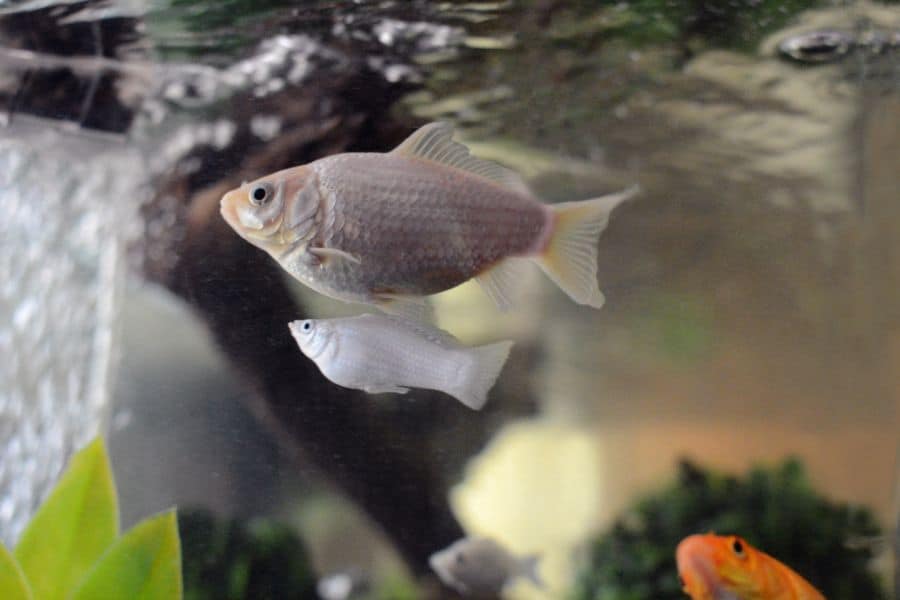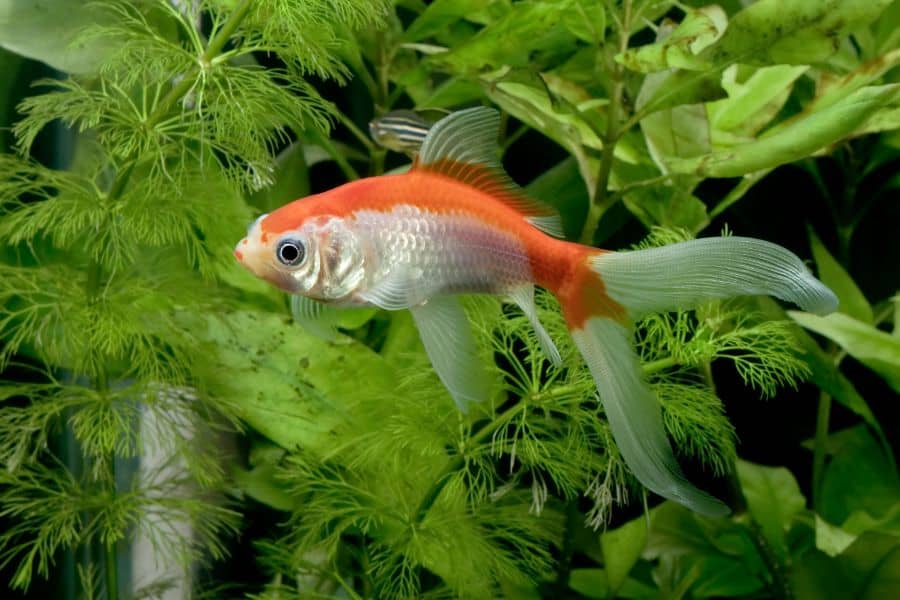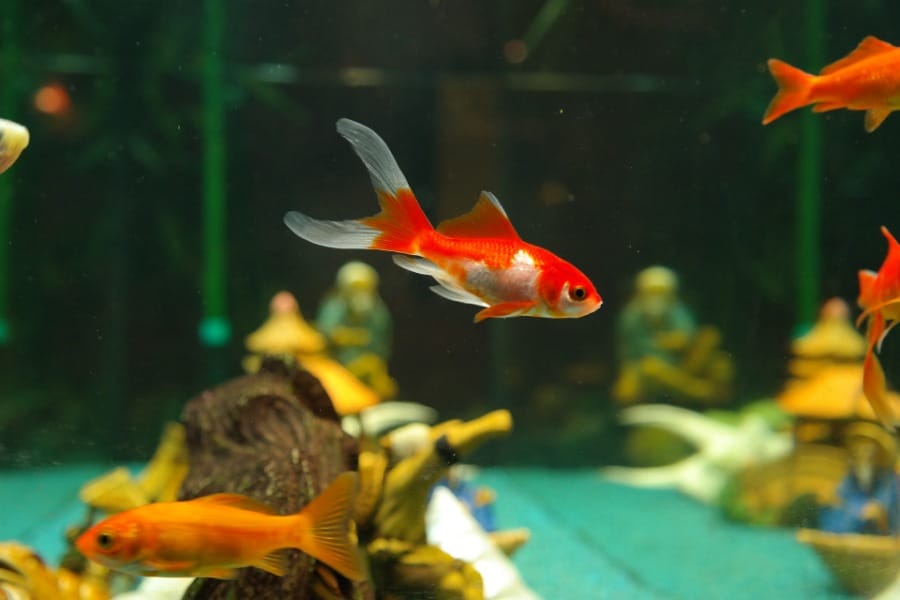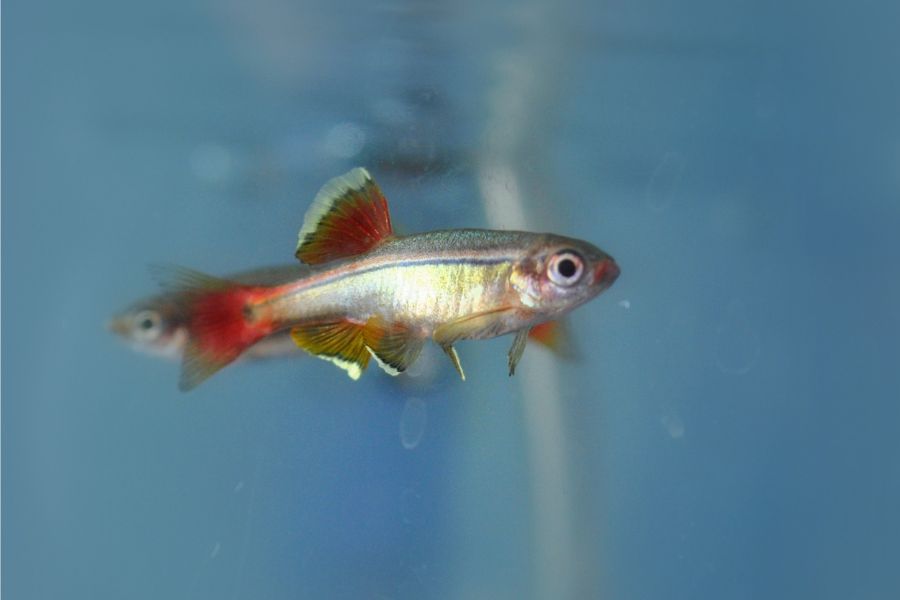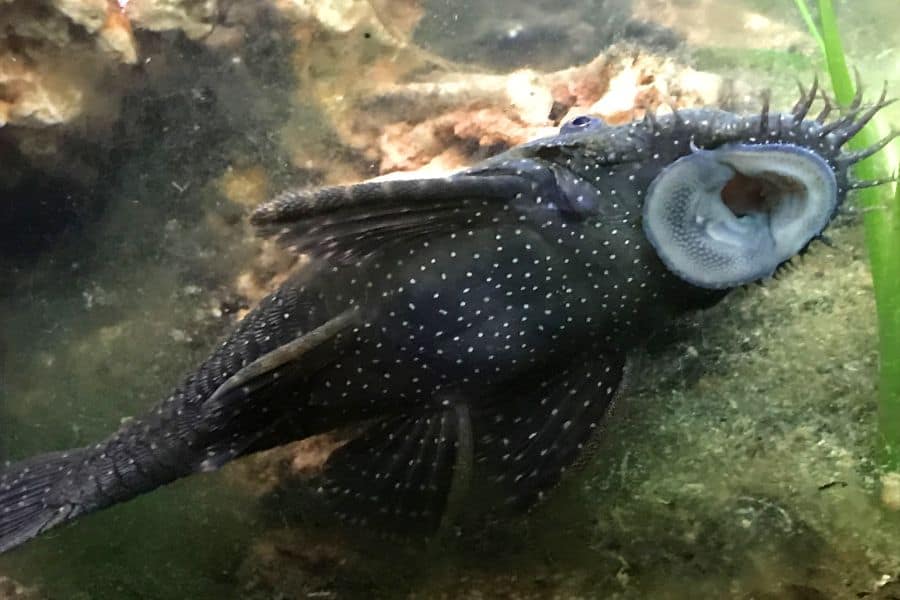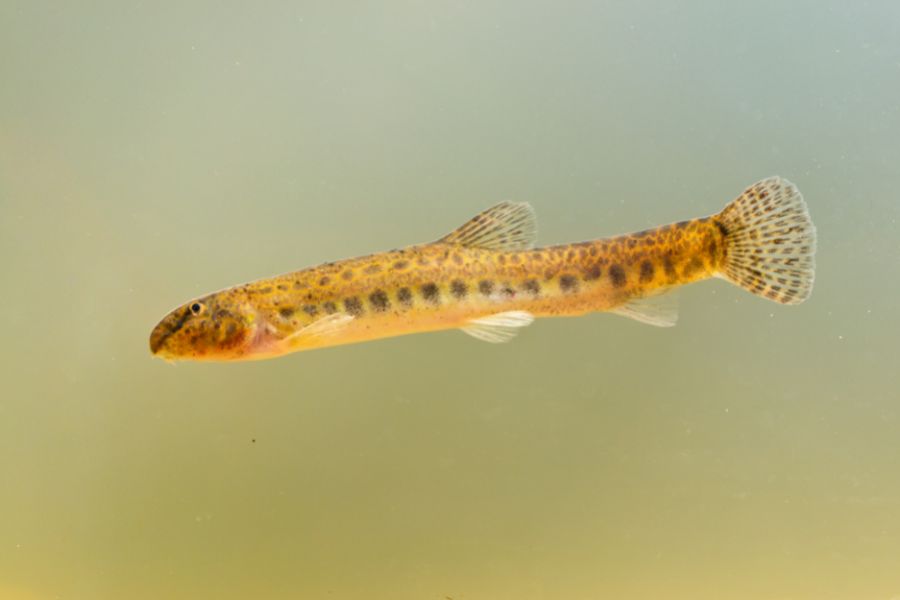When it comes to the aquarium trade, there’s probably no fish as recognizable and as popular as the iconic goldfish.
But did you know that there are actually many types of goldfish in the world? One of them is the gorgeous comet goldfish, a lovely goldfish variant characterized by its long forked tail.
This guide is all you need to take care of comet goldfish as a beginner aquarist. We’ll discuss everything you want and need to know about this goldfish variant, such as comet goldfish care, comet goldfish lifespan, comet goldfish lifespan, and more!
Comet Goldfish Basics
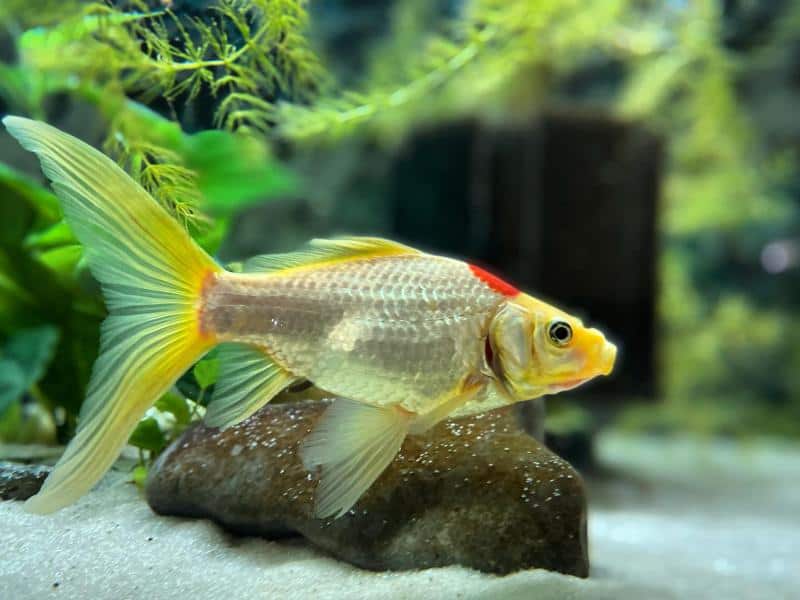
- Name: Comet Goldfish
- Scientific Name: Carassius auratus
- Water temperature: 65-75°F (18-24°C)
- pH levels: 6.0 to 8.0 (6.5 to 7.5 preferred)
- Water hardness: 5 to 19 dKH
The comet goldfish is a very popular goldfish variant found around the world. It’s also one of the most commonly kept pet fish in the United States.
However, they’re not naturally occurring fish, which means they can’t be found in the wild.
The original species they’re derived from, the Prussian carps (Carassius gibelio) are cool water fish typically found in lakes, streams, and other slow-moving bodies of water. They were endemic to Europe, specifically in the central regions, but were widely distributed through trade.
Comets themselves are a hybrid of other goldfish variants that were bred in captivity. They’re not as inbred as other fancier types, though, making them relatively more hardy.
Still, they do have specific care requirements, especially when it comes to water parameters. It’s best if you have a water testing kit like the API Freshwater Master Testing Kit on hand so that you can periodically test their tank water.
Comet Goldfish Origins
As mentioned above, the goldfish species is a relative of the common carp. From there, they were selectively bred to create the various goldfish variants that we know and love today.
The comet goldfish variant first appeared in the late 19th century. A fishkeeping enthusiast and self-described “florist and aquarist” by the name of Hugo Mulertt was breeding various types of goldfish when he discovered that some of the offspring had long, forked tails.
Coincidentally, it was also around this time that the “Great Comet of 1881” or C/1881 K1 appeared in the skies. The comet had an exceptionally long, bright tail, kind of similar to this specific goldfish strain.
Mulertt thought the resemblance between his new goldfish and the comet was too strong to ignore. He decided to name the new variant, “Comet Goldfish.” As the variant become more and more popular, the name stuck, and now we have the comet goldfish as we know it now.
Mulertt would go on to write several books about fishkeeping, particularly about rearing ornamental fish like goldfish, which was his favorite fish breed.
Comet Goldfish Appearance
Comet goldfish may look like common goldfish at first glance, but they do have distinct features that set them apart from each other. Let’s discuss them in this section.
Comet Goldfish Tail
The main difference between other goldfish variants and comet goldfish is the caudal fin, also known as the tail fin.
Comet goldfish are single-tailed, which means they have one tail fin that grows from their caudal peduncle, the area near the tail.
However, unlike other goldfish, comet goldfish tails are typically longer and forked deeply in the middle. It can even reach up to half the fish’s body length, giving it a graceful and elegant look.
Their long tail also gives them a look similar to a comet moving across the sky – exactly the reason why Mulertt gave this variant its distinctive name.
Keep in mind that the forking may not be as deep when comets are younger, which means they may not be as visible. They should be fully forked when they reach adulthood, though.
Aside from the caudal fin, comet goldfish can also be characterized by their large dorsal fin, long pectoral fins, and slim anal fin.
Comet Goldfish Colors
Comet goldfish can be quite diverse when it comes to coloration.
Typically, they have the standard color that other goldfish variants have, which is red, orange, and yellow. Their fins, although usually white or at least semi-opaque, can also be marked with the same colors as the rest of their body.
However, there are also other colors popular among hobbyists. Here are some of them.
Sarasa Comet Goldfish
Some comet goldfish may have a mainly white body peppered with colored spots all throughout. This white-peppered variant is referred to by the name “Sarasa comet.”
“Sarasa” is the Japanese term for “calico,” referring to the mottled white and red pattern of this type.
Tancho Comet Goldfish
The Tancho comet can be considered a subvariant of the Sarasa, although some goldfish enthusiasts argue that it’s a distinct variant in its own right.
Tancho comets, or Tancho Sarasa comets, can be identified by the unique red circle on their heads. This is similar to the shape of the Japanese flag, also known as “Hinomaru.”
The name Tancho is derived from the Tancho koi, also known as the Hinomaru koi, which is a type of koi that has the same marking pattern.
Black Comet Goldfish
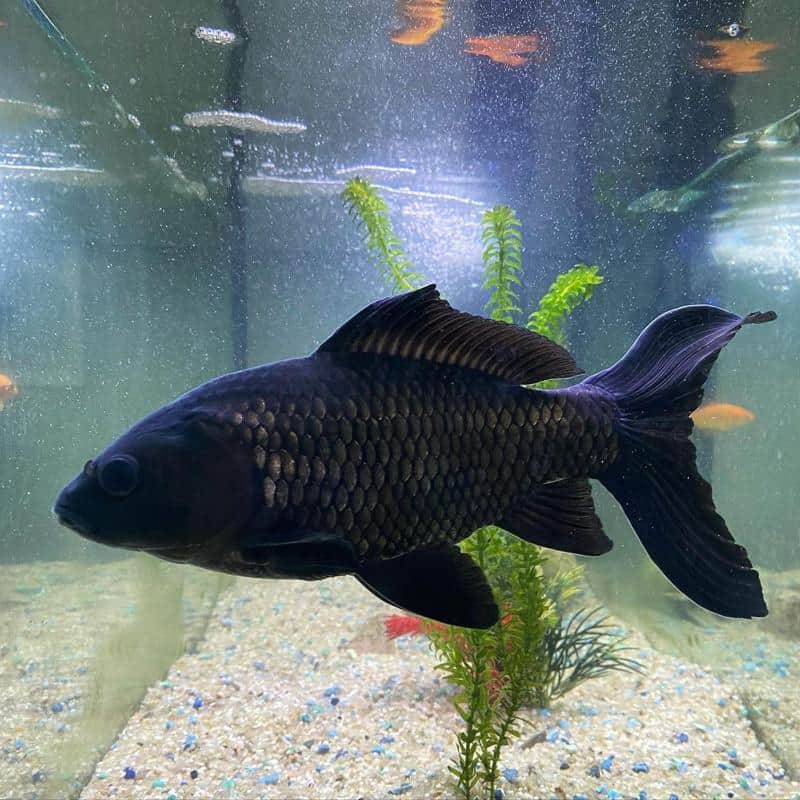
Black comet goldfish are also becoming increasingly popular, even though they’re fairly new in the hobby.
This variant is characterized by its black coloration, which is caused by melanin pigmentation. This type of comet goldfish can also have other colors such as yellow or orange in other parts of their body, particularly their underbelly.
However, the base color should always be black, and it should make up the majority of their coloration.
Yellow Comet Goldfish
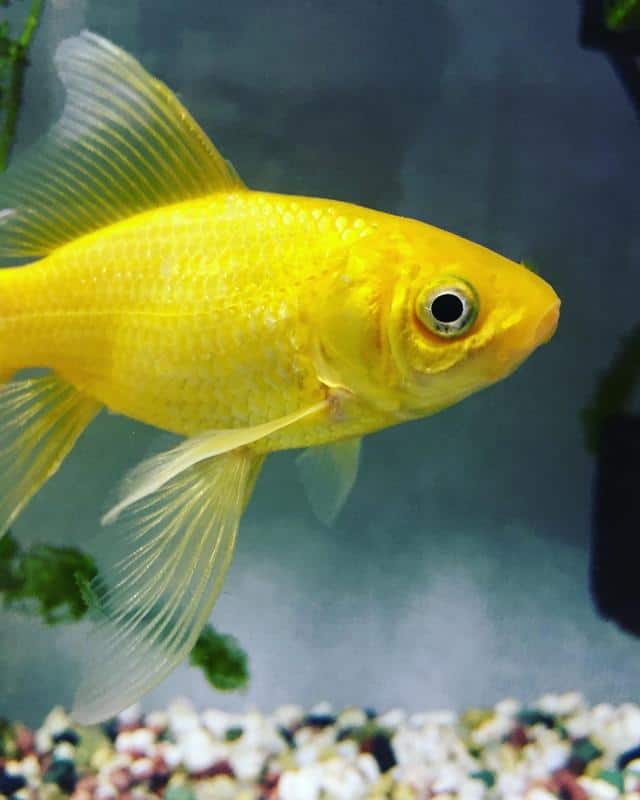
Although yellow isn’t an extremely rare color for a goldfish, it is rare for comets to be entirely yellow.
There’s a bit of history behind this. Many centuries ago, it was allegedly not allowed for ordinary people to own pure yellow goldfish. Since yellow was considered one of the colors of the elite, only the ruling class was allowed to keep them.
Luckily today, there’s no longer any social class that’s privileged enough to keep yellow goldfish. In other words, they’re now available for anyone who wishes to have these lovely yellow-colored creatures in their tanks.
Typically, yellow comet goldfish have a vibrant, metallic sheen to their color, which is why some aquariums and local shops may also call them “Golden comets.”
White Comet Goldfish
Another color variant of comet goldfish is white. White comets usually differ from their darker counterparts by having a more muted coloration, which makes them look almost like a pearl.
That said, don’t mistake this for a non-white comet suddenly turning white. If your comet was originally a different color and it suddenly starts lightening to the point of becoming almost white, there could be an underlying problem.
Make sure you check if it’s exhibiting any symptoms to determine if it’s indeed healthy or not.
Comet Goldfish Male or Female
If you’re wondering if you have a male or female comet goldfish, there are some signs that can help you figure out the gender.
The easiest way to tell is to check the pectoral fins, also known as those fins located near the gills. Males typically have thicker pectoral fins and wider fin rays than females.
Males also tend to be more slender, especially when viewed from above. During the spawning season, they may develop spike-like bumps on their gills and pectorals, as well. These are known as breeding tubercles. You may be inclined to think that they’re symptoms of skin diseases, but they’re actually perfectly normal.
On the other hand, female comet goldfish are usually rounder in shape. When viewed from above, they’re noticeably wider than males, particularly if it’s around their breeding season.
Keep in mind that it’s much harder to differentiate the gender between young comet goldfish. It’s best to wait for at least a year or so before you check if your comet goldfish is male or female.
Comet Goldfish Size
When it comes to comet goldfish size, you may be surprised at how big they can really get.
Most people get their comet goldfish as a juvenile. During this time, they may be as small as 2-3 inches.
Some beginner fishkeepers may think that this means their comet goldfish won’t need a bigger space. However, this couldn’t be more false.
In this section, let’s talk about comet goldfish size, including how big they can get and how fast they grow.
How Big Do Comet Goldfish Get?
Comet goldfish can grow to be as large as 8-12 inches. It’s also not unheard of to find some specimens that can exceed that.
This is why it’s very important to make sure you get a sufficiently large tank for your comet goldfish. A 30-gallon tank should be enough for a single specimen, but you may want to consider getting a bigger tank for multiple comets.
Keep in mind that the golden rule when it comes to fish tanks is to always get a tank that’s bigger than what you think you need. Even better, get as big as you possibly can! This will help ensure your comet goldfish get to live a happy, healthy life in their new home.
How Fast Do Comet Goldfish Grow?
Comet goldfish can grow quickly if given the right conditions. If you have a well-maintained tank with the correct parameters, your comet goldfish should reach its maximum size within a year or two.
It’s also possible for your comet goldfish to grow even bigger if you provide it with a larger tank and plenty of food. This can result in some specimens reaching over a foot in length.
On the other hand, this means that comet goldfish growth can be stunted if the tank is too small or has poor water quality. Additionally, a sudden change in temperature or pH can also affect your comet goldfish’s growth.
This is why it’s always important to make sure the tank conditions are optimal for your comet goldfish. With proper care, your comet goldfish can reach its full size in the fastest and healthiest way.
Comet Goldfish Lifespan
Comet goldfish lifespan can vary depending on the size of the tank, water conditions, and other factors.
In general, though, a comet goldfish can live up to 10-15 years in captivity. Some may even live up to 20 or more years if they’re well taken care of.
It’s also important to remember that comet goldfish lifespan can be affected by different factors. Poor water quality, inadequate tank size, and improper diet can all contribute to your comet goldfish’s life expectancy.
So, if you want to ensure that your comet goldfish lives a long and healthy life, make sure to provide it with all the necessary conditions. This way, you can ensure that your comet goldfish lives out its full life expectancy and enjoys a good life in the process.
Comet Goldfish Tank Size
Comet goldfish require a tank size of at least 30 gallons for one adult individual, but it is recommended to choose an even larger tank if possible.
As mentioned above, the larger the tank is, the better it will be for them. Some aquarists suggest 50-75 gallons for a single individual, as this will give them more room to swim around and stay active.
Others even say that comet goldfish are better reserved for ponds, where they can fully reach their natural length without feeling cramped.
That said, we understand that not everyone can accommodate this tank size. 30 gallons should be the bare minimum, as long as it comes with a good filter and you can stay on top of water changes.
Of course, if you want to keep more than one fish, you’ll need a bigger space for them. At the bare minimum, make sure you add at least 15-20 gallons for every new comet goldfish you add.
How Many Comet Goldfish Per Gallon?
The rule of thumb when it comes to deciding the tank size for any species of fish is typically “one inch per gallon.” This means that for each 10-inch fish, there should be 10 gallons of water.
However, this doesn’t take into consideration several factors, such as water chemistry, oxygen levels, and filtration.
Comet goldfish are messy eaters and equally messy poopers. Their bioload tends to be greater than most other species out there, which is why they don’t follow the 1-inch-per-gallon rule.
How Many Comet Goldfish in A 10-Gallon Tank?
No comet goldfish should be kept in a 10-gallon tank, as this is insufficient space for these fish to grow and thrive.
As we said above, comet goldfish need a minimum tank size of 30 gallons, and even then, it’s not enough to keep multiple individuals. If you plan on keeping a group of comet goldfish, it’s best to opt for a larger tank size that can accommodate all of them.
Comet Goldfish Tank Setup
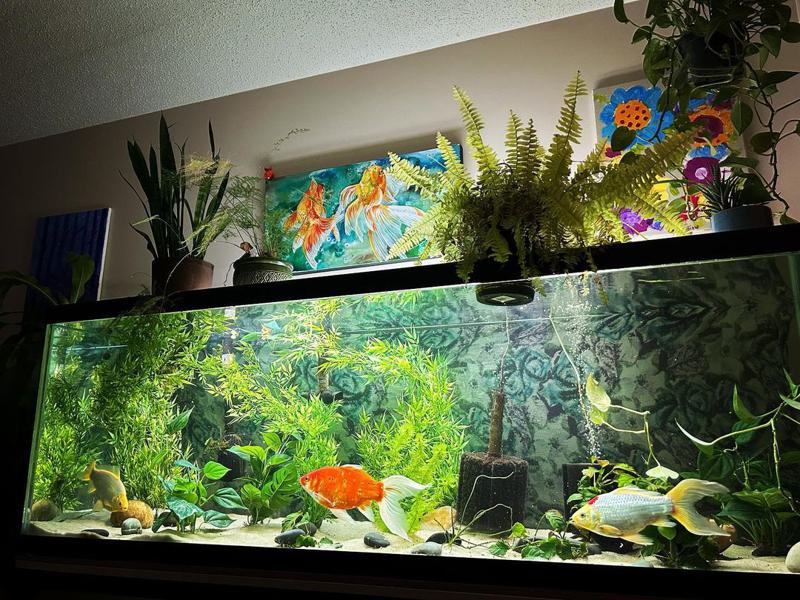
Fortunately for beginner aquarists, comet goldfish tank setup is incredibly easy.
Goldfish, in general, aren’t too picky when it comes to their environment. They can live in a tank, in a pond, and even in a makeshift aquarium.
The bare necessity they need is proper filtration, as they can be quite messy eaters. But don’t worry – we’ve got you covered. This section outlines everything you need for the perfect comet goldfish tank setup.
Filtration
This is the most important factor when it comes to setting up an aquarium for your comet goldfish.
Comet goldfish, like other goldfish breeds, produce a lot of waste, so a good filter is absolutely essential.
When getting a filter for your comet goldfish, it’s much better to go bigger than to go smaller. In fact, we recommend getting a filter that is rated for at least twice the tank size you’re using, as this will ensure that your water remains clean and your fish are healthy.
Here are some of the best filters for comet goldfish on the market right now:
It’s also a good idea to not make the flow too strong, as your comet goldfish may have a hard time swimming against it.
Lighting
Comet goldfish don’t need special lighting to stay healthy, but if you want to add a bit of life to your aquarium, you can add an LED light.
Unlike filters, we recommend getting only the minimum light you need for your fish. Basically, anything that allows you to see them clearly is enough.
The best type of lighting for comet goldfish is white or orange-colored LED lights. These lights don’t emit heat and are gentle enough on their eyes. Additionally, white or orange LED lights should bring out your comet goldfish’s colors and make them look more vibrant.
If you want to try this out for your comet goldfish, consider purchasing full-spectrum lights like Hygger’s Programmable Aquarium LED Light. Since this is fully programmable, you can select specific colors like orange for your tank.
Don’t forget that fish need to have a proper cycle of light and dark in order to sleep, so make sure that you turn the lights off at night.
If you’re worried that you might forget, you can purchase timers like the TP-Link KASA Smart Mini Plug that will turn the lights on and off for you automatically.
Substrate
Your choice of substrate can have a big impact on the overall health of your comet goldfish. Comets are big on bottom-feeding, which means they like rummaging around the bottom of the tank in search of food.
For this reason, we recommend using a sandy substrate for your comet goldfish tanks, such as AquaNatural’s Oolitic Aragonite Sand or Caribsea’s Arag-Alive Fiji Aquarium Sand. You can even use Seachem’s Fluorite Black Sand if you don’t want a white-colored substrate.
Sand is softer and won’t hurt your comet goldfish’s delicate fins even if they do scrape against it from time to time. Additionally, sand also helps keep the water clean by keeping debris and uneaten food that would otherwise dirty the water on top.
You can also opt for fine gravel instead, like Carib Sea’s Peace River Gravel and AquaNatural’s Diamond Black Premium Gravel. Even though these gravel grains are only 1-2mm each, they do have the added benefit of being heavier than sand, which means they won’t shift around too much.
Some fishkeepers use a combination of both – fine gravel on top of sand – as it will help keep the sand at the bottom and provide a bit more cushion for your comet goldfish.
Decorations
You can also add decorations to your comet goldfish tank. Comets are very active fish, so you can add items like rocks, driftwood, caves, and plants to give them some places to explore.
One problem with live plants is that goldfish tend to nibble on them. You’ll need to pick plants that are particularly hardy, such as water sprites, java ferns, cryptocorynes, and anubias.
Ideally, there should be a combination of both slow and fast-growing plants in your tank so that your comet goldfish have something to nibble on but don’t eat them all.
Of course, when adding decorations to your tank, make sure they don’t have any sharp edges that could potentially injure your fish. Also, like with other types of goldfish, you should be very careful when using artificial decorations as these can leach harmful chemicals into the water.
Comet Goldfish Care
Taking care of comet goldfish isn’t difficult once you have the right setup. However, it’s still important that you do your research to ensure that they’re getting the best level of care.
Comet Goldfish Temperature
Comet goldfish are cold-water fish, so their tank should be kept at a temperature between 65-75°F (18-24°C). They do prefer the lower end of this range, though.
That said, don’t keep the water too cold either. Water that’s too cold means they won’t be able to digest their food properly.
Meanwhile, water that’s too hot can cause them to become stressed and lead to health issues such as bloating.
Comet Goldfish Diet
So, here’s an important question any beginner aquarist asks at the start of their fishkeeping journey: what do comet goldfish eat?
Well, the answer is simple: they love variety. As omnivores, they need a wide range of food to stay healthy. You can feed them once or twice a day with a combination of commercial fish pellets, freeze-dried krill, brine shrimp, and other prepared foods.
They will also appreciate live or frozen treats like bloodworms, tubifex worms, and daphnia.
Additionally, you can also add vegetables to your comet goldfish’s diet. Lettuce, peas, cucumbers, broccoli, and spinach are all great choices. Just make sure to blanch them before giving them to your fish, as this helps make it easier for them to digest.
Comet Goldfish Common Diseases
Although comet goldfish are relatively hardy, they’re still not immune to diseases. Here are some of the most common comet goldfish diseases that you need to watch out for.
- Ich: Also known as white spot disease, ich is a parasitic disease characterized by itchy white spots that appear on the comet goldfish’s body.
- A similar disease to ich. It’s very common in goldfishes that have a weakened immune system. It makes the gills and fins extremely irritated.
- Fin rot: This bacterial disease slowly “eats” away at the fins of a comet goldfish, eventually resulting in them becoming damaged and frayed.
- Swim bladder disorder. A common health problem in many fish, including comet goldfish. It’s caused by a number of factors, including poor water quality, overfeeding, and genetic defects.
If you notice any signs of illnesses in your comet goldfish, you should immediately put them in a separate hospital tank and treat them with the appropriate medication.
Comet Goldfish Tank Mates
If you want to have a community tank with your comet goldfish, you’re in luck.
Comet goldfish are rather peaceful fish that can be kept with other even-tempered species, including other compatible goldfish breeds.
However, where you may find trouble is finding a good match for them that’s not another goldfish.
That’s because of three things:
- They need cooler water.
- They have a massive bioload.
- They’re fast eaters.
While the first and second factors can be easily solved by getting cold-water fish and a good filtration system, the third one is a bit more complicated.
Many peaceful fish are not that competitive when it comes to food, which means they may not be able to compete for food with your comet goldfish. And since comet goldfish tend to eat whatever is on sight, some of your tank inhabitants will likely go hungry.
As such, you’ll need to make sure that any tank mates you get can either eat faster than your comets or can get food from somewhere else.
Here are some of the best tank mates you can get for your comet goldfish community tank.
Other Goldfish
Other goldfish breeds like shubunkins and commons can do well with comets, as long as you give them enough room to swim and thrive.
These fish already have the same tank requirements so you don’t have to worry about any compatibility issues when it comes to that aspect.
However, keep in mind that not all goldfish make good tank mates. Some fancy goldfish breeds, like the long-tailed veiltail goldfish, are much too slow-moving for comets, which means they won’t be able to compete for food.
Others, like the bubble eye goldfish, are too delicate to be housed with the super active, super playful comet goldfish.
White Cloud Mountain Minnow
A popular community fish, these little guys are fast swimmers and can easily grab some munchies during feeding time.
Plus, white cloud mountain minnows can tolerate colder waters, making them compatible with goldfish. They also don’t require any special care, as long as you keep their tank clean and give them enough room to move around.
Bristlenose Plecos
These little algae eaters are perfect for tanks with comet goldfish.
Aside from their peaceful and easygoing nature, there’s one more thing that makes them great tank mates with comet goldfish: plecos mainly eat on the tank floor.
This means they won’t need to join in on the feeding frenzy and will stay safe from the comet goldfish’s innate playfulness.
Weather/Dojo Loaches
Weather loaches, also known as dojo loaches, are another great companion for comet goldfish.
These cold-water fish are fast, hardy, and super resilient to diseases, even when kept in overcrowded tanks.
Dojo loaches also have a knack for scavenging, which means they won’t miss out on food during feeding time. Plus, they have a peaceful temperament and tend to get along well with other fish in the tank.
Snails
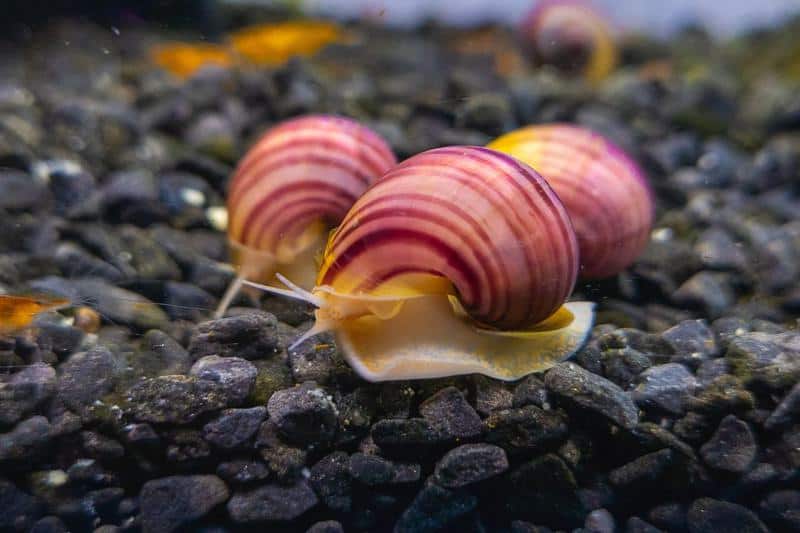
If you’re looking for a great way to add another species to your tank while also keeping it free of algae at the same time, you may want to consider snails.
Snails are fantastic algae eaters, particularly peaceful species like Nerites and mystery snails. Due to their size, they won’t add much to the tank’s bioload.
Breeding Comet Goldfish
Love comet goldfish so much that you want to try your hand at breeding them?
Comet goldfish are actually pretty easy to breed, provided that you have the right setup.
- Prepare their breeding area. The first and most important thing you need is a large breeding area. This is because there needs to be enough room for the adults and their fry to swim separately without any risk of injury or aggression.
- Consider ponds. Many breeders actually put their breeding pairs in small ponds during the breeding season to ensure that there’s no shortage of space. Keep in mind, these fish can lay up to 1,000 eggs at a time. If the breeding tank is too small, they won’t be able to mate no matter how long you leave them together.
- Check the water parameters. Regardless if you have a pond or a big tank, make sure the area is clean, well-filtered, and free of any parasites or bacteria that can harm your fish. The temperature should also be just right, as the eggs won’t hatch if it’s too cold or too hot.
- Add in the decor. Don’t forget to add in your artificial plants and hiding places. These will give your fish a sense of security and make them feel more comfortable in the breeding tank. Once the baby fry hatch, they will also use these hiding spots to hide from the adults who may want to gobble them up.
- Pair up the fish. Once you have your breeding area ready, simply condition and pair up your chosen comet goldfish. Remember to keep an eye on them, as both the male and female comets can get a little feisty during spawning.
- Separate the eggs. In case you’re lucky enough to see the eggs before they hatch, you can put them in a separate tank for safekeeping. You should see the comet goldfish eggs hatching in about a week’s time. They don’t need to eat yet at this point, so you let them swim around on their own for the first few days.
- Feed the fry. After the fry finishes the egg sac, it’s time to give them food that they can swallow and digest. This includes small pieces of live food like brine shrimp, daphnia, and egg yolk.
Also Read:
FAQs
What’s the Difference Between Comet Goldfish and Shubunkin?
The answer to this question depends on who you ask. Some people think that Shubunkin are just another subvariant of comet goldfish, just with a specific pattern and coloration.
Others think that Shubunkin deserve to be their own variant since they have too many differences from regular comet goldfish.
Are There Green Comet Goldfish?
Comet goldfish come in a variety of colors, including green. That said, if you’re looking for a comet goldfish that’s the color of a tree, then you’ll be disappointed. Their green looks more like a dark olive than a green apple, with the color often appearing on their fins and tails.
How Often Should I Feed My Comet Goldfish?
Comet goldfish should be fed once, twice, or even thrice daily in small portions – basically, anything they can finish in 2-3 minutes.
You don’t want to overfeed them as this can lead to health problems down the line, such as bloating. Too much food can also dirty the tank, resulting in poor water conditions that can negatively affect your goldfish’s health.
Do Comet Goldfish Care for Their Young?
Comet goldfish have no parental instincts at all. In fact, their adults may even eat their own eggs and fry if given the chance. To avoid this, it’s best to separate the adults from the fry as soon as possible.
Before you do that, however, make sure to cover all the areas of the tank with a net or something similar to prevent the adults from getting to the fry.
Do Comet Goldfish Need an Air Pump?
Comet goldfish don’t need an air pump if you already have a good filter going. The main benefit that an air pump has for a comet goldfish is extra oxygen.
With a strong filtration system, however, the circulation should already be good enough. Of course, you can always add an air pump and a bubbler to your comet goldfish tank if you want to.
Conclusion
These are just some of the basics when it comes to caring for comet goldfish, but as you can see, there’s already a lot to learn.
Remember to always keep their water clean, provide them with a nutritious diet, and ensure they have enough space to move around, explore, and thrive. With the right care, your comet goldfish can certainly live their best life!
